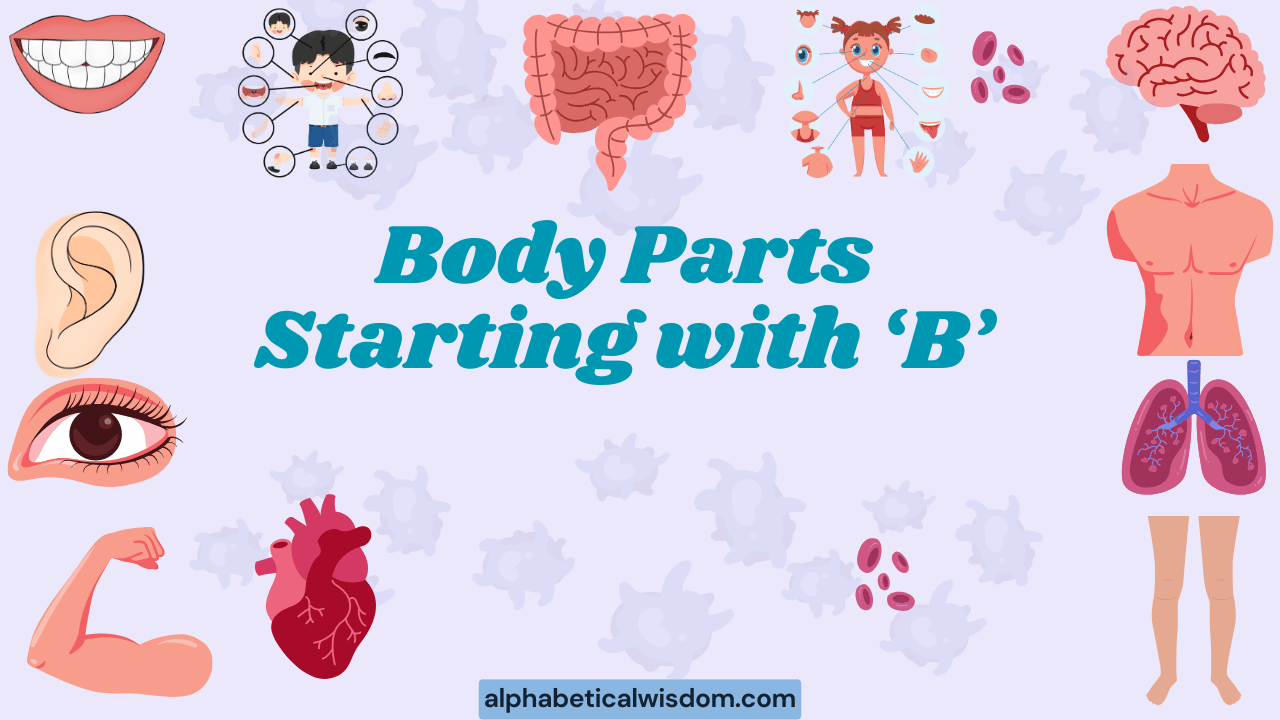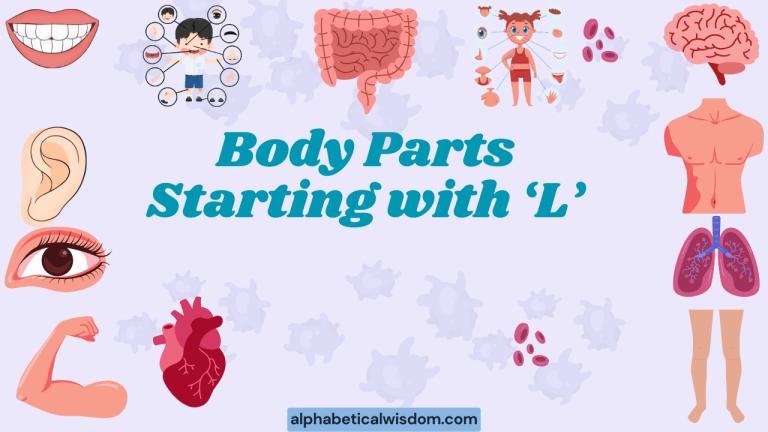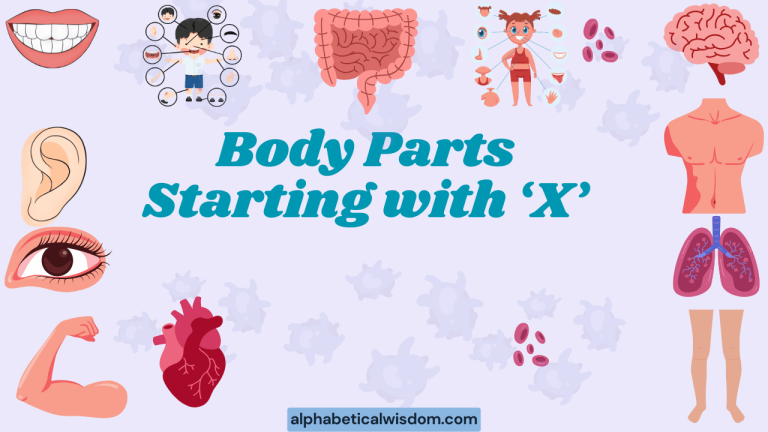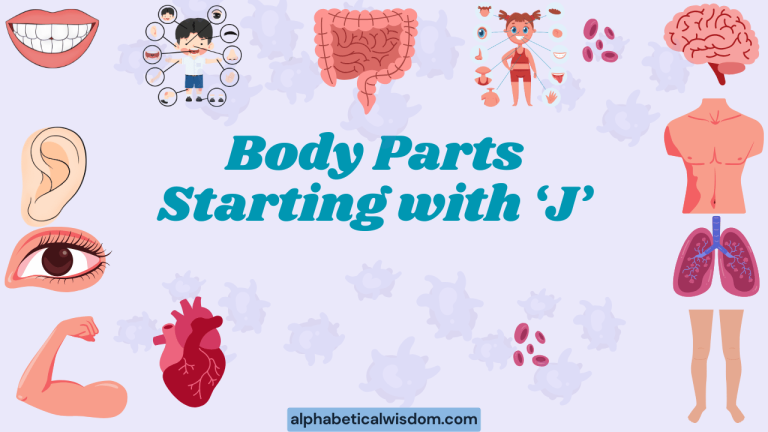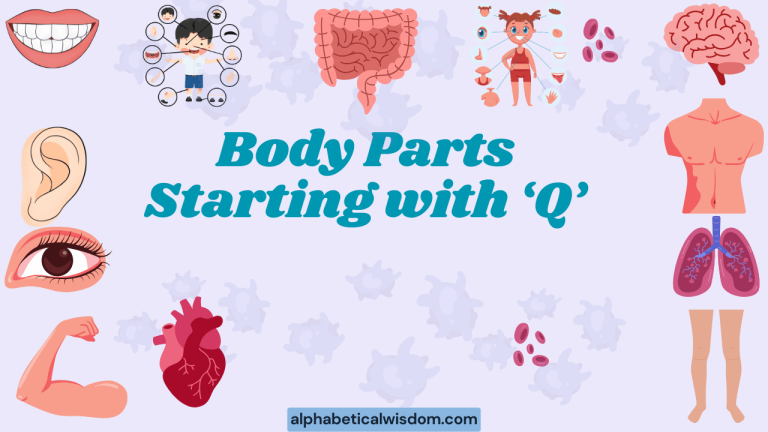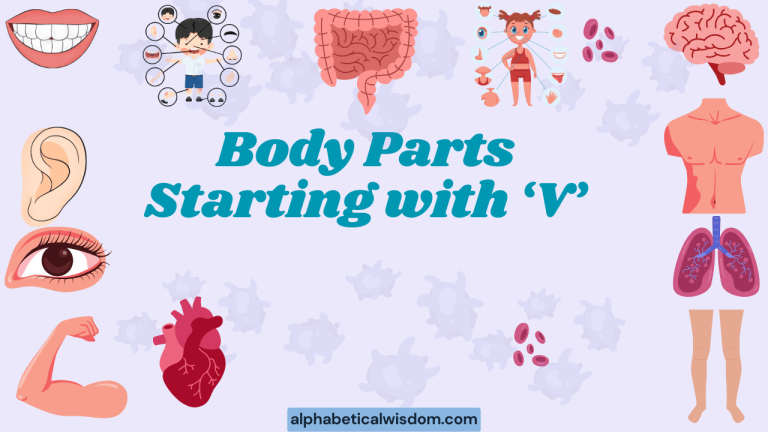Body Parts Beginning with ‘B’: A Grammar Guide
Understanding the names of body parts is crucial for effective communication in English. This article focuses specifically on body parts that start with the letter ‘B’, exploring their grammatical functions, common usages, and potential pitfalls.
Whether you’re a beginner or an advanced learner, this comprehensive guide will enhance your vocabulary and improve your understanding of English grammar in the context of anatomical terms. This detailed exploration will not only expand your lexicon but also deepen your appreciation for the nuances of the English language.
By mastering these terms, you can more accurately describe physical attributes, medical conditions, and everyday actions.
Table of Contents
- Introduction
- Definition: Body Parts Starting with ‘B’
- Structural Breakdown
- Types and Categories
- Examples
- Usage Rules
- Common Mistakes
- Practice Exercises
- Advanced Topics
- FAQ
- Conclusion
Definition: Body Parts Starting with ‘B’
Body parts starting with the letter ‘B’ encompass a variety of anatomical terms, including bones, body sections, and biological fluids. These terms function as nouns within sentences, and their usage can vary depending on the context.
Understanding their specific meanings and grammatical roles is essential for accurate communication. The classification of these terms helps in organizing and learning them effectively.
For instance, ‘back’ refers to a body section, while ‘bone’ is a structural component, and ‘blood’ is a vital biological fluid. Each term has distinct characteristics and usage patterns.
In English grammar, these nouns can be singular or plural, countable or uncountable (depending on the specific word), and can be modified by adjectives and used in various sentence structures. For example, “He has a back injury” uses ‘back’ as a singular noun, while “The bones in his hand are broken” uses ‘bones’ as a plural noun. The term ‘blood’ is generally uncountable, as in “He lost a lot of blood.” Correct usage requires understanding these nuances.
Structural Breakdown
The structural breakdown of body part names starting with ‘B’ involves understanding their noun forms and how they fit into different sentence structures. These nouns can function as subjects, objects, or complements within a sentence. They can be modified by adjectives to provide more specific information. For instance, “the strong back,” or “the fractured bone.”
Furthermore, these nouns can be used with prepositions to form prepositional phrases, adding further detail and context. Examples include “on his back,” “in the bone marrow,” or “full of blood.” The correct use of articles (a, an, the) also plays a crucial role in conveying the intended meaning. “A broken bone” implies one unspecified bone, while “the back pain” refers to a specific instance of back pain.
Understanding the grammatical relationships between these nouns and other parts of speech is essential for constructing grammatically correct and meaningful sentences. Consider the following examples to illustrate this point:
- Subject: The back aches.
- Object: He injured his back.
- Complement: The problem is the broken bone.
- Prepositional Phrase: The surgery was on his back.
Types and Categories
Body parts starting with the letter ‘B’ can be categorized into several types, including bones, body sections, and biological fluids. Each category has its specific characteristics and grammatical considerations.
This categorization helps in organizing and understanding the different terms more effectively.
Bones
Bones are rigid organs that form the skeletal structure of the body. Examples include the backbone, breastbone, and other less common terms.
Grammatically, bones are countable nouns, meaning they can be singular or plural. They often appear in medical contexts and discussions about anatomy.
Body Sections
Body sections refer to specific areas or regions of the body. Examples include the back, belly, and brow.
These terms are typically singular and refer to a general area, although they can sometimes be pluralized when referring to multiple instances or conditions. They are commonly used in everyday language to describe physical sensations, injuries, or appearances.
Biological Fluids
Biological fluids are substances produced by the body that serve various physiological functions. The primary example in this category is blood.
Blood is generally an uncountable noun, referring to the fluid as a whole rather than individual units. It is a crucial term in medical contexts and discussions about health.
Examples
To further illustrate the usage of body parts starting with ‘B’, the following sections provide extensive examples organized by category. Each example demonstrates the grammatical function and context of the term in a sentence.
Examples with Bones
This section focuses on examples using ‘bone’ related terms. The examples demonstrate how these terms function as nouns, both singular and plural, and how they interact with other parts of speech within a sentence.
The following table presents a variety of sentences using ‘bone’ related terms. Each example is designed to illustrate how the term functions grammatically and how it can be used in different contexts.
| Sentence | Grammatical Function |
|---|---|
| The backbone is essential for support. | Subject |
| He injured his backbone in the accident. | Object |
| The doctor examined the patient’s breastbone. | Object |
| The breastbone felt tender to the touch. | Subject |
| The X-ray showed a fracture in the backbone. | Object of preposition |
| She has a strong backbone. | Object |
| The backbone supports the body. | Subject |
| He felt pain in his backbone after lifting the heavy box. | Object of preposition |
| The child’s breastbone was prominent. | Subject |
| The surgeon operated on the patient’s breastbone. | Object |
| The backbone is also known as the spine. | Subject |
| She needed surgery to repair her damaged backbone. | Object |
| The breastbone protects the heart and lungs. | Subject |
| He felt a sharp pain in his breastbone after the fall. | Object of preposition |
| The doctor explained the function of the backbone. | Object of preposition |
| The athlete strengthened his backbone with exercises. | Object |
| The infant’s breastbone was carefully examined. | Subject |
| The backbone provides structural support for the body. | Subject |
| He complained of discomfort around his breastbone. | Object of preposition |
| The backbone is a column of vertebrae. | Subject |
| The breastbone is located in the center of the chest. | Subject |
| She had a problem with her backbone and needed physical therapy. | Object |
| The doctor said his breastbone was bruised but not broken. | Subject |
| Injuries to the backbone can be very serious. | Object of preposition |
| Proper posture helps to protect the backbone. | Object |
| The location of the pain was right over his breastbone. | Object of preposition |
Examples with Body Sections
This section provides examples of sentences using ‘body section’ terms. These examples illustrate how these terms are used to describe specific areas of the body and how they function grammatically within a sentence.
The following table presents sentences using ‘body section’ terms, such as ‘back’, ‘belly’, and ‘brow’. Each example demonstrates the term’s grammatical function and usage in different contexts.
| Sentence | Grammatical Function |
|---|---|
| Her back was aching after the long day. | Subject |
| He felt a sharp pain in his back. | Object of preposition |
| She rubbed sunscreen on her belly. | Object of preposition |
| The baby’s belly was full after feeding. | Subject |
| He furrowed his brow in concentration. | Object |
| Her brow was sweaty from the exercise. | Subject |
| The massage helped ease the tension in her back. | Object of preposition |
| He lay on his back and looked at the stars. | Object of preposition |
| She felt butterflies in her belly before the presentation. | Object of preposition |
| The doctor examined his belly for any signs of swelling. | Object |
| He wiped the sweat from his brow. | Object |
| Her wrinkled brow showed her concern. | Subject |
| The weightlifter strained his back during the lift. | Object |
| She had a tattoo on her lower back. | Object of preposition |
| He patted his belly after the large meal. | Object |
| The pregnant woman’s belly grew larger each day. | Subject |
| He raised his brow in surprise. | Object |
| Her furrowed brow indicated she was thinking hard. | Subject |
| The yoga helped to stretch her stiff back. | Object |
| He applied ice to his sore back. | Object of preposition |
| She felt bloated in her belly after eating too much. | Object of preposition |
| The doctor listened to the sounds in his belly. | Object of preposition |
| He shielded his eyes with his brow. | Object |
| Her smooth brow was a sign of relaxation. | Subject |
Examples with Biological Fluids
This section focuses on the biological fluid ‘blood’, illustrating its grammatical function and usage in various contexts. Given ‘blood’ is most commonly used, the examples are centered around it.
The following table presents sentences using the term ‘blood’. Each example demonstrates how ‘blood’ functions grammatically as an uncountable noun and its usage in different contexts.
| Sentence | Grammatical Function |
|---|---|
| The cut was bleeding blood. | Object |
| He lost a lot of blood after the accident. | Object |
| The doctor tested his blood for diseases. | Object |
| His blood type is O negative. | Subject |
| The vampire craved blood. | Object |
| The scientist analyzed the blood sample. | Object |
| The wound was covered in blood. | Object of preposition |
| Donating blood can save lives. | Object |
| The detective found traces of blood at the scene. | Object of preposition |
| The blood flowed freely from the wound. | Subject |
| The transfusion replaced the lost blood. | Object |
| She donated blood to the hospital. | Object |
| The blood test revealed high cholesterol. | Subject |
| The shark smelled blood in the water. | Object |
| The nurse took a sample of his blood. | Object |
| The blood clotted quickly. | Subject |
| The victim was covered in blood. | Object of preposition |
| She needed a blood transfusion after the surgery. | Object |
| The blood pressure reading was normal. | Subject |
| The vampire thirsted for blood. | Object |
| The lab technician analyzed the blood sample carefully. | Object |
| The crime scene was splattered with blood. | Object of preposition |
| Regular blood donations help save lives. | Subject |
| The forensic team examined the blood stains. | Object |
Usage Rules
The usage of body part names starting with ‘B’ follows standard English grammar rules for nouns. These nouns can be singular or plural, and their usage depends on the context of the sentence.
Uncountable nouns like ‘blood’ require different grammatical treatment than countable nouns like ‘bone’.
Agreement: Ensure subject-verb agreement when using these nouns. For example, “The back aches” (singular) versus “His bones ache” (plural). The correct article usage (a, an, the) is also crucial. “A broken bone” refers to any broken bone, while “the broken bone” refers to a specific one.
Prepositions: Pay attention to the correct prepositions used with these nouns. Common examples include “on his back,” “in the bone,” and “full of blood.” Incorrect preposition usage can alter the meaning of the sentence.
Adjectives: Use appropriate adjectives to modify these nouns and provide more specific information. For example, “a strong back,” “a fractured bone,” or “fresh blood.” The choice of adjective can significantly impact the description and meaning.
Common Mistakes
One common mistake is incorrect pluralization. For example, saying “backs” when referring to a general condition rather than multiple backs.
Another mistake is using the wrong preposition, such as “at his back” instead of “on his back.”
Another frequent error involves misusing uncountable nouns. For instance, saying “a blood” instead of “some blood” or “a lot of blood.” Understanding the countable and uncountable nature of these nouns is crucial for correct usage.
Here are some examples of common mistakes and their corrections:
| Incorrect | Correct | Explanation |
|---|---|---|
| He has two backs. | He has back pain. | “Backs” implies multiple backs, while “back pain” refers to a condition. |
| She fell at her back. | She fell on her back. | The correct preposition is “on.” |
| I see a blood. | I see blood. | “Blood” is uncountable and doesn’t take the indefinite article “a.” |
| The bones is broken. | The bones are broken. | Subject-verb agreement: “bones” is plural, so the verb must be “are.” |
| He hurt his backbone’s. | He hurt his backbone. | Unnecessary possessive form. |
Practice Exercises
The following exercises will help you practice using body part names starting with ‘B’ correctly in sentences. These exercises cover various aspects of grammar, including fill-in-the-blanks, sentence correction, and multiple-choice questions.
Exercise 1: Fill in the Blanks
Fill in the blanks with the appropriate body part starting with ‘B’.
| Question | Answer |
|---|---|
| He injured his ______ while lifting heavy weights. | back |
| The doctor examined the patient’s ______ for any abnormalities. | belly |
| She furrowed her ______ in concentration. | brow |
| The X-ray showed a fracture in his ______. | backbone |
| The ______ protects the heart and lungs. | breastbone |
| He lost a lot of ______ after the accident. | blood |
| She felt pain in her lower ______. | back |
| The baby’s ______ was full after feeding. | belly |
| He wiped the sweat from his ______. | brow |
| The surgeon operated on her ______. | backbone |
Exercise 2: Sentence Correction
Correct the following sentences that contain errors in the usage of body part names starting with ‘B’.
| Incorrect Sentence | Correct Sentence |
|---|---|
| He has two backs. | He has back pain. |
| She fell at her back. | She fell on her back. |
| I see a blood on the floor. | I see blood on the floor. |
| The bones is broken. | The bones are broken. |
| He hurt his backbone’s. | He hurt his backbone. |
| She has a strong backbones. | She has a strong backbone. |
| He has pain in his bellys. | He has pain in his belly. |
| She raise her brows. | She raised her brow. |
| The breastbone are sore. | The breastbone is sore. |
| He need a blood. | He needs blood. |
Exercise 3: Multiple Choice
Choose the correct sentence from the options provided.
| Question | Options | Answer |
|---|---|---|
| Which sentence is correct? | (a) He has a back pain. (b) He has back pain. (c) He have back pain. | (b) He has back pain. |
| Which sentence is correct? | (a) She fell on her backs. (b) She fell on her back. (c) She fall on her back. | (b) She fell on her back. |
| Which sentence is correct? | (a) I see some blood. (b) I see a blood. (c) I sees blood. | (a) I see some blood. |
| Which sentence is correct? | (a) The bones is broken. (b) The bone is broken. (c) The bones are broken. | (c) The bones are broken. |
| Which sentence is correct? | (a) He hurt his backbone’s. (b) He hurt his backbone. (c) He hurt his backbones. | (b) He hurt his backbone. |
| Which sentence is correct? | (a) She has a strong backbones. (b) She has a strong backbone. (c) She have a strong backbone. | (b) She has a strong backbone. |
| Which sentence is correct? | (a) He has pain in his bellys. (b) He has pain in his belly. (c) He have pain in his belly. | (b) He has pain in his belly. |
| Which sentence is correct? | (a) She raise her brows. (b) She raised her brow. (c) She raises her brow. | (b) She raised her brow. |
| Which sentence is correct? | (a) The breastbone are sore. (b) The breastbone is sore. (c) The breastbones is sore. | (b) The breastbone is sore. |
| Which sentence is correct? | (a) He need a blood transfusion. (b) He needs blood transfusion. (c) He needs a blood transfusion. | (c) He needs a blood transfusion. |
Advanced Topics
For advanced learners, exploring idiomatic expressions and figurative language involving body parts starting with ‘B’ can be beneficial. For example, “stab someone in the back” is an idiom meaning to betray someone.
Understanding these nuances requires a deeper understanding of cultural context and linguistic subtleties.
Further advanced study could involve analyzing the etymology of these words, tracing their origins and evolution through the English language. This provides insight into the historical and cultural influences that have shaped their meanings and usages.
Additionally, studying medical terminology related to these body parts can expand vocabulary and improve comprehension in specialized contexts.
Another area of advanced study is the use of these terms in literature and poetry. Authors often use body part names metaphorically to convey deeper meanings and emotions.
Analyzing these literary usages can enhance interpretive skills and provide a richer understanding of the language.
FAQ
Here are some frequently asked questions about using body part names starting with ‘B’.
- Is “blood” countable or uncountable?
“Blood” is generally uncountable, referring to the fluid as a whole. You would say “a lot of blood” or “some blood” rather than “a blood.” However, in specific scientific contexts, it can be used countably to refer to different types of blood samples, but this is rare in everyday usage. - How do I use “back” correctly in a sentence?
“Back” can be used as a noun (e.g., “He injured his back”), an adjective (e.g., “back pain”), or an adverb (e.g., “back home”). Ensure you use the correct preposition when necessary, such as “on his back” or “behind his back.” - What is the difference between “brow” and “eyebrow”?
“Brow” and “eyebrow” are often used interchangeably, but “eyebrow” specifically refers to the arch of hair above the eye. “Brow” can also refer to the forehead area more generally. - Can “belly” be used in formal writing?
“Belly” is generally considered informal. In formal writing, “abdomen” is a more appropriate term, especially in medical or scientific contexts. - How do I pluralize “backbone”?
The plural of “backbone” is “backbones.” This is a regular plural formation, following the standard rule of adding “-s” to the end of the singular noun. - What are some common idioms using “blood”?
Common idioms include “blood is thicker than water” (family bonds are stronger than other relationships), “bad blood” (bitter feelings), and “in cold blood” (deliberately and without emotion). - How do I use adjectives with body part names starting with ‘B’?
Place the adjective before the noun, as in “a strong back,” “fresh blood,” or “a furrowed brow.” The adjective should accurately describe the quality or characteristic of the body part. - Is it correct to say “backs” when referring to back pain?
No, it is not correct. You should say “back pain” or “lower back pain.” “Backs” implies multiple backs, which is not the intended meaning. - When should I use “abdomen” instead of “belly”?
Use “abdomen” in formal, medical, or scientific contexts. “Belly” is more appropriate for informal conversations or when referring to a baby or child’s stomach. - Can “back” be used as a verb?
Yes, “back” can also be used as a verb, meaning to support or move backward. For example, “I back your decision” or “He backed the car out of the driveway.” However, this is unrelated to its use as a body part noun.
Conclusion
Mastering the usage of body parts starting with the letter ‘B’ requires understanding their grammatical functions, contexts, and potential pitfalls. This comprehensive guide has provided a detailed overview of these terms, including their definitions, structural breakdowns, and usage rules.
By practicing the exercises and reviewing the common mistakes, you can significantly improve your accuracy and fluency in English.
Remember to pay attention to subject-verb agreement, proper preposition usage, and the countable or uncountable nature of these nouns. Continued practice and exposure to the language will further solidify your understanding and confidence in using these terms correctly.
Keep exploring new vocabulary and grammar concepts to enhance your overall language proficiency.
